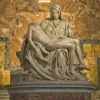| Title | Creator | Date | Era | City | Country | Emotional Sum (Sense of Life or emotional World View) | Theme | |
|---|---|---|---|---|---|---|---|---|

|
Chariot of Apollo | Sculptor: Tuby, Jean Baptiste (1630-1700) | 1668-1670 | 1600s | The world has thrilling powerful men of action. There are no limits to what can be achieved. |
Elegant, physical power. The fantasy ability to fly through water and air with grace and ease.<br> |
||

|
David | Sculptor: Buonarotti, Michelangelo | 1504 | 1500s | Man is a strong, indomitable creature who has the intelligence to overcome terrible odds. | [requires assumption of some context of this work -- not a "cold" introduction to it]: A man able to face a daunting task, with tremulous calm and determination. This is the depiction of the David/Goliath story of the Bible in which David takes on the much more formidable Goliath and wins. |
||

|
Niobe | Sculptor: unknown | c. 200 BC | Human action is beautiful. | Life is movement. |
|||

|
Pieta | Sculptor: Buonarotti, Michelangelo | 1500 | 1500s | United States | Resignation in the face of tragedy. | Recognition and acceptance of a great personal loss. |
|

|
Rape of Polyxena, The | Sculptor: Fedi, Pio | 1866 | 1800s | United States | Strength and complex beauty are central. Vitality, passion and action are hallmarks of this work. |
Life is complex strife, entwined with strong god-like characters. |
|

|
Three Graces | Sculptor: Canova, Antonio | 1814 | 1800s | The female human form is beautiful, graceful, ideal. | Quiet repose and sisterly love. The piece exudes a quiet elegance and peacefulness amidst the complex three-dimensional composition. The inclusion of "sisterly love" is less certain, except that taking into account the mythological background of the piece. It can be argued that one should not take that into account, so perhaps that should not formally be included in the theme. |
||

|
Laocoon (Laocoön and His Sons) | Sculptor: Agesander | 1st century BCE to 1st century CE | 500 BCE - 1 CE | United States | Life is a desperate, agonizing struggle. | The heroic but agonizing defeat of Men. This sculpture certainly represents at the same time the heroic nature of men but cast into an impossible situation that can only be tragic. |
|
| |
La Grande Nevrose | Loysel, Jacques | c.1896 | 1800s | The dynamic female body is beautiful and exciting. Although it may not explicitly suggest it, the nude and its tense position could be felt as erotic. | An animated female body is a vessel of perfection. |
||
| |
Riace Bronze A | Myron? | c.460 BCE | 500 BCE - 1 CE | Reggio Calabria | Italy | Man is strong and indomitable | Intelligence, Pride, Strength = Man |

|
Shade, The | Rodin, Auguste | 1880-1904 | 1900s | Paris | France | Life is a gruesome trial. There is no hope. | The world destroys man. (Some unknown evil force is destroying this young strong man.) Given that the sculpture is titled as a "Shade" and is related to the Group sculpture "Gates of Hell", one can presume the evil is some unnamed condition that can overpower life and cause destruction of the good. |

|
Winged Victory | Sculptor: unknown | 190 BCE c. | 500 BCE - 1 CE | Paris | France | One of the great expressions of the Greek Classical and Hellenistic spirit -- that men (and women) are larger than life and triumphant. While the image is partially a fantasy since the woman is winged and probably represents a goddess: Nike -- this concretization depicts a "god" in the form of a human woman, thus glorifying women. |
The grandeur of being alive and free. |